The Stylish Living Room and Kitchen focuses on the appropriate layout and design. Color scheme, furniture arrangement, lighting, texture, and finish add up to create a comfortable and functional space.
This article advises on lighting, furniture, and color schemes that bring together functionality and flair to help with designing a cozy, harmonious living space and a kitchen.
Whether you’re starting from scratch or remodeling, here are some ideas that could help create a stylish and inviting home.
1. Selection of a Color Scheme for Your Living Room and Kitchen
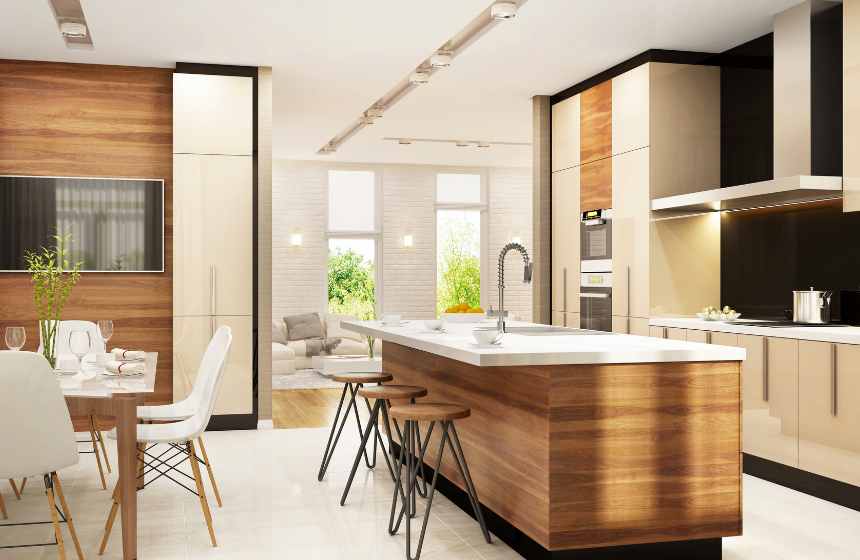
Choosing the right color palette to make the stylish living room and kitchen is important in setting the mood and harmony inside the house.
A good color scheme may seamlessly join the two adjacent areas, ensuring a cohesive and inviting environment all around.
a). Establish a Neutral Base
Neutrals such as grays and beige’s are such great shades; they give you a great space to play with, no matter how you fancy it. You can create stunning pops of accents that do not take over the room with well-balanced backgrounds from these shades.
Start from this neutral background, popping with accent walls, furniture, and accessories in colorful shades.
b). Add Bold Accents
After the establishment of a neutral base, earthy greens and more saturated jewel tones like amethyst, sapphire, or emerald could be used.
These colors can bring character and warmth into the kitchen and living room, together giving each space a more vibrant and well-thought-out feel.
Bold accents in an open-plan arrangement could help create distinct zones while conserving overall coherence.
Also Read: Greenify Your Home: A Guide to Sustainable Interior Design
c). Consider natural light
Lastly, the light a space receives from natural sources should be contemplated as a guide in the use of colors. Light and airy places like bedrooms or living rooms may take darker and more intense colors because they will be balanced and deepened by the former.
Conversely, lighter hues should be used in dimmer areas so that the space does not feel closed and cramped. Combinations of light pastels, off-whites, or soft blues can greatly increase the perception of openness in these shadowed spaces.
d). Factor in Mood and Function
Colors can be very meaningful in terms of ambient energy within a space. Softer blues and greens are good for restive spaces, such as the living room, while the brighter reds and oranges can really energize a space, making it feel welcoming for conversation, where it would be appropriate to introduce functionality like the kitchen.
e). Mix Textures and Finishes
The surface finishes and textures contribute to, rather than distract from, your color choices. A matte finish gives soft elegance, while a glossy surface provides the modern, sleek look.
Mixing different textures, such as combining a matte wall with glossy furniture, metallic lighting, or metallic surfaces, will provide visual interest and depth, making spaces feel designed and inviting.
f). Use Accessories for Flexibility
Curtains, carpets, and throw cushions are excellent accessories in giving texture and color without dominating the space. You simply update the space over time by changing these components according to the seasons or your tastes.
Artwork and ornament should complement your color scheme for the space to be in harmony with the design and enhance the ambiance.
g). Reflect Personal Style and Function
This means that your color scheme should express the personality yet consider the functionality of every area. Consider what purpose each room would be used for-for instance, the stylish living room and kitchen may flourish under riotous colors that bring about action, whereas the living room could work better with gentle shades that help to induce relaxation.
A well-chosen color palette has the potential to transform your house into a fashionably comfortable space.
Also Read: Home Library Decor Tips: Create Your Perfect Reading Retreat
2. Arranging Furniture for Comfort and Function
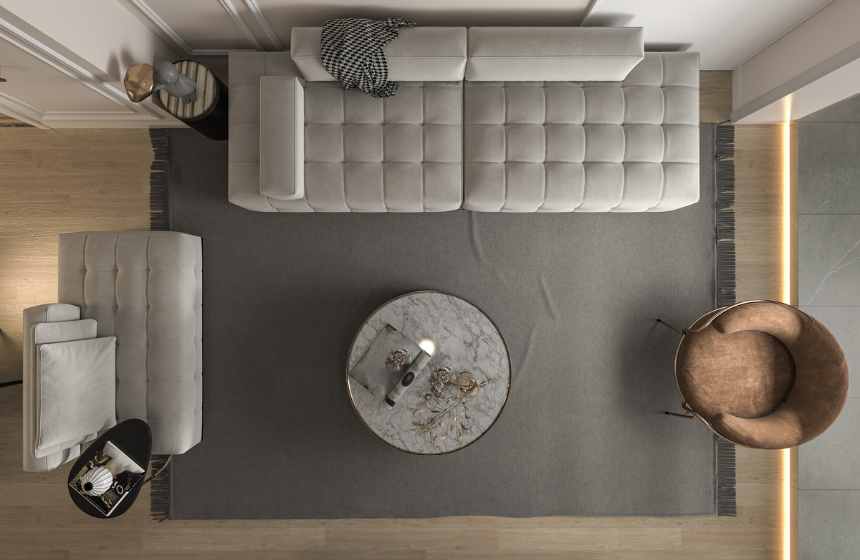
Good furniture arrangement in a living room and kitchen should occupy a useful space which is very comfortable so that there is ease in the communication process and flow.
Properly placed furniture will improve the atmosphere and make good use of available space.
a). Optimize Space and Flow
The flow of your furniture should encourage circulation and sociability. Open plans demand a thoughtful circulation route that does not lead to dead-end situations, congestion, or blocking.
Make sure to think through how your furnishings might define the flow of movement while being uncluttered and spacious. Position conversation seating; sofa and chair positions may be facing each other or arranged around a central focal point such as a coffee table, television, or fire.
b). Balance Form with Function
The right furniture layout balances form and function. Utilizing space and mobility help with the choice to employ multi-functional items that can serve several purposes, such as an extendable dining table working well for everyday family dinner, a larger-than-average gathering, or a sectional sofa with chaise also lends itself to use as a guest bed.
In positioning furniture in a room, each piece must be positioned with intention and provides emphasis of the design in the room.
c). Foster Communication and Comfort
In the living room, seating should be constituted in a manner that also encourages conversation and relaxation. Head-to-head sofas and chairs communicate a sense of being intimate and close.
Dining chairs set round a table in the kitchen fill up a warm spot during meal time and discussion. That purpose is to create hospitable spaces that encourage people to come together and then naturally interact with each other.
d). Prioritize Traffic Flow
There must be a clear flow through all of the areas, but particularly in an open design. Areas should not be cluttered with big furniture pieces to block pathways and restrict movements.
There should be enough space for people to move around between rooms without being restricted and to interact with one another.
Also Read: 12 Genius Home Bedroom Items on a Budget
e). Begin with larger.
More permanent furniture pieces should be considered when designing your room-for example, sofas, tables, and storage units. You can add smaller items like side tables, accent chairs, and ottomans to round out the effect once you’ve placed these crucial pieces.
Using this approach keeps functionality in mind while each individual piece works well within the larger scheme of the room.
f). Integrating technology and storage solutions
It really can greatly improve both functionality and aesthetics. Consider where to put outlets, charging stations, and built-in storage to reduce clutter and hide cables and cords.
Ample, thoughtful storage options – like those built-in shelves or hidden places – add to a spacious, clean feeling that makes the space more inviting.
3. Optimize Space and Flow in Open-Plan Designs
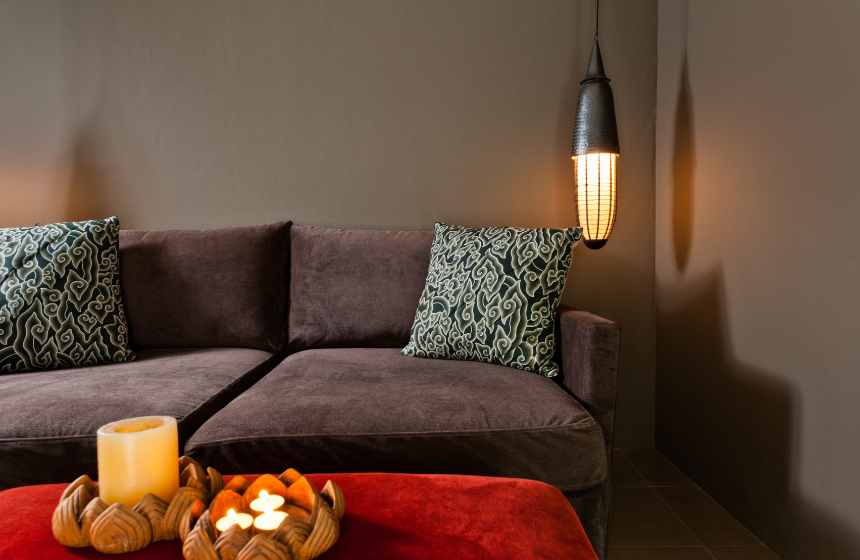
With an open plan, living, dining, and kitchen areas can all come together into a single flowing space with flexible unification. Still, in order to ensure a flowing and functional arrangement, careful planning must enhance the space and flow.
You can create different activity zones yet still maintain openness and airiness in the space by the well-planned zone separation.
a). Define Different Zones
One of the most important strategies in the open-plan design is defining the zones of cooking, dining, and relaxing. The openness fostered by this type of design sometimes makes it challenging to identify the different functions within the open plan.
The devices used to define these zones are area rugs, the furniture arrangement, and unique lighting. Area rugs can help to anchor the living space and the dining space while a proper furniture arrangement will create natural separations between the three functions.
For instance, a sofa is a partition of the living and dining zones, and a kitchen island defines zones of cooking and dining.
Also Read: 12 Easy Bedroom Refresh Ideas to Create a Relaxing Sanctuary
b). Layered Lighting for Ambience
For many purposes, even defining spaces must be carried by lighting and thus the appropriate mood depends on that. Layered lighting will ensure each area is well lit while allowing a flexible ambiance.
For example, overhead pendant lights over the kitchen island can be considered highly functional as a task light but using floor or table lamps will add warmth and softer glow in the living room.
Dimmer switches could literally add a scintillating atmosphere by letting you decide the light levels adjustable, whether you are entertaining company, cooking, or unwinding.
Combining task, ambient, and accent lighting helps build a dynamic environment designed to suit individual activities.
c). Strategically Located Furniture
The first rule for furniture placement is that it cannot obstruct the flow in open-plan areas. For instance, never put bulky furniture along the path as this can obstruct and cause congestion in the atmosphere.
Try placing the furniture against the walls or use it to define certain zones, such as lining up a sofa against one wall and separating the living area from the dining space visually.
It also provides flexibility in a modular setup, with arrangements changing according to seating or tables meeting changing needs or layout over time.
This comes in very handy, especially when required in an open-plan space where requirements may shift around.
d). Seamless Storage Solutions
In the case of an open-space, there is a need to include storage solutions in the design to make the room pleasantly tidy. Built-in shelves and cabinets, as well as multi functional furniture, could really keep the area organized while giving aesthetic appeal.
Consider making use of storage units as nice, subtle dividers to separate different areas, but without the requirement of walls. For instance, a tall bookshelf can visually separate the living room and the kitchen while supporting some much-needed storage.
e). Manage Acoustics
Open spaces tend to create acoustic problems because sound tends to bounce off the hard surfaces, thus increasing levels of noise. To improve acoustics and make the environment more comfortable, consider soft furnishing in the form of curtains, cushions, and rugs.
These tend to absorb the sound and reduce the amount of echoed noise since it will be quieter and warmer. Acoustic panels or fabric wall hangings are also effective for handling noise problems while at the same time serving as an effective decorative feature.
Also Read: The Integration of Technology in Kitchen Gardening
4. Selecting Adaptable Furniture for Both Spaces
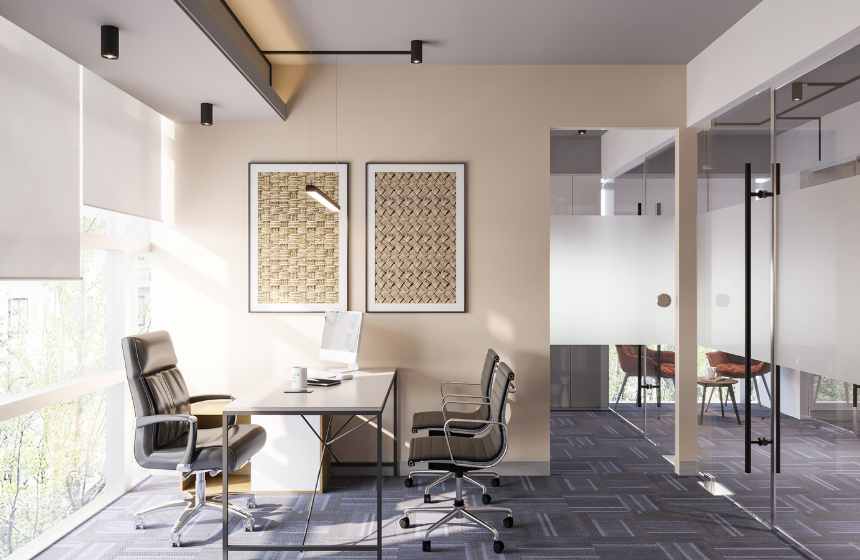
You should use multi-functional furniture when you are designing an open-plan living room and kitchen. Perfect pieces can fulfill several purposes and can seamlessly change spaces, thus optimizing your open-plan design.
By prioritizing versatility and use, you can be sure that all furniture you furnish adds to your home’s functionality as well as beauty to sure stylish living room and kitchen.
a). Multi-functional pieces
Hence choose those furniture products that you can use multiple times or easily adjust to use in different spaces. A dining table with extending leaves is ideal to serve everyday meals but for larger gatherings when the situation arises.
A modular sofa will help you change the seating depending on your needs: such as when hosting your friends or having some quiet time with the family. This flexibility makes it ideal for rooms that serve a variety of purposes, like a living-dining room.
b). Built-In Storage Solutions
There is the right furniture which can make great use of your space by featuring built-in storage. You will then have an always tidy and organized home.
For example, a coffee table that has concealed compartments will keep your remotes, magazines, and other pieces small in the living room but not so much in your eye.
Islands are a practical storage island in the kitchen, which not only provides additional countertop space for meal preparation but also houses handy storage for utensils, cookware, or small appliances.
These smart storage options keep the essentials within a hand’s reach while maintaining an impossibly clean and polished look of your stylish living room and kitchen.
c). Material Selection and Durability
The material of your choice will heavily determine how durable and maintainable your furniture will be. It makes sense to invest in tough fabrics and finishes that can stand up very well under some wear and tear, especially when it comes to families.
Leather or specialty fabrics for seating would be quite good because they tend to be clean and maintenance-friendly, even with kids or pets. Another thing is texture.
This would combine smooth metal dining chairs with plush fabric cushions to enhance the visual appeal of the space, creating interest and contrast.
Also Read: Top Home Decor Mistakes to Avoid for Stylish Spaces
d). Comfortable and Flexible Seating
The first thing to consider when choosing seats for your living and kitchen is comfort. The ideal seat would be one with the convenience of swinging between the two rooms, particularly for entertaining or more additional guests.
Examples include adjustable-height stools. They are excellent for either a kitchen island or a living room bar since it can be adjusted to suit other levels.
Paying attention to comfort and flexibility, you can ensure that the seating arrangement will meet both daily use and special occasion requirements.
e). Visual Coherence and Style
While functionality is very important, it should also contribute to visual harmony in both your living and kitchen space. So consider furniture pieces with matching wood finishes or complementary color schemes in order to create a seamless flow between the two spaces.
Cushions, throws, rugs etc can add warmth and character to furniture pieces while making refreshing your decor very easy. These can be changed by the seasons and, therefore, you can change the design without carrying out a complete renovation.
5. Lighting Options for Your Living Room and Kitchen
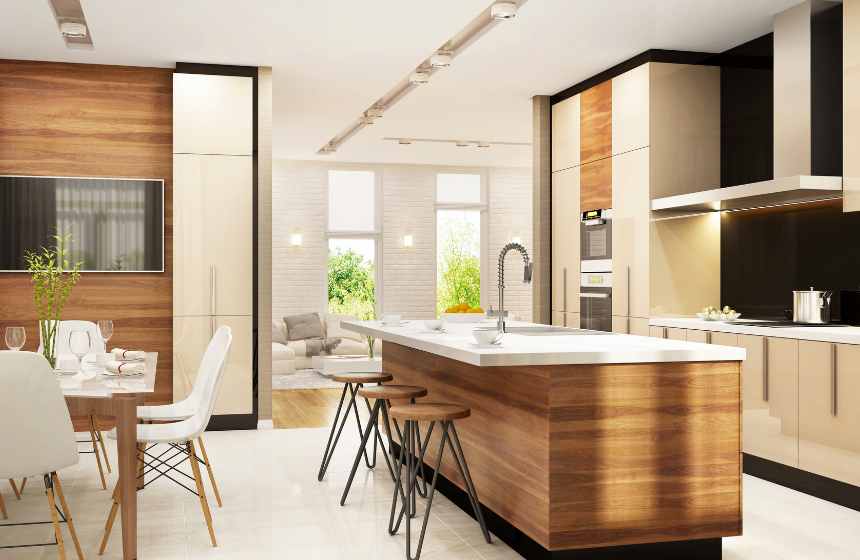
Lighting is one aspect of setting and usability in your living room and kitchen. With proper choices and coordination of various sources of lighting, you can create a warm atmosphere that will be highly flexible.
Consider both natural and artificial light types to ensure that the space has sufficient illumination for several activities.
a). Maximize Natural Light
Start with a perception of how direct sun in your living room and kitchen would be an influence. Where possible, enhance the daylight flow in your home through sheer curtains or blind functions.
It will allow light penetration into the stylish living room and kitchen while preserving some element of privacy and possibly controlling brightness.
A bright space makes the openness and airiness of the atmosphere attractive, a useful factor in the kitchen, where good lighting is a prerequisite for cooking and meal preparation.
b). Ambient Lighting for Whole Brilliance
Ambient lighting is the basic level of lighting in a space. This provides the general level of brightness and maintains the general ambiance of the room.
Consider chandeliers, recessed lighting, or fixtures that can be mounted directly on the ceiling as wonderful options for ambient lighting. These elements spread light out over an area and ensure that no part of the room stands in darkness.
To achieve an even distribution, position ambient lighting centrally in the room or above important areas like the kitchen or living room.
c). Task Lighting for Focused Activities
Add task lighting to provide concentrated illumination of specific activities. Under-cabinet lights in the kitchen can provide downlit practical lighting useful for meal preparation by illuminating countertops for cooking tasks.
In the living area, floor lamps or reading lights placed near seating areas create concentrated light that is useful for reading or other detailed activities.
Task lighting should be directed where the most value can be gained; this can help minimize eye fatigue and maximize functionality.
Also Read: Minimalist Home Decor: Essential Tips for a Neat & Clean Space
d). Accent Lighting to Highlight Decoration
Accent lighting gives the room depth and visual interest by focusing attention to given areas or decorated elements. Some ideas are spotlights, track lighting focusing on some artwork or architectural details or unique collections.
Pendant lights set up to hover just above the island or a dining table in the kitchen serve as functional as well as aesthetic items. The given fixtures add to the general look of the place but also create focus points that lift up the aesthetic of living and kitchen areas.
e). Dimmer Switches for Flexibility
A dimmer switch is an excellent upgrade for any room by making the light changeable, especially at the time of day or during the activity.
Whether one is having a party or just having some time with family or cooking in the kitchen, lowering the lights helps achieve the suitable ambiance.
This flexibility will greatly affect the whole mood within the space-changing the bright and jovial mood to a warm and appealing one.
f). Consider the Color Temperature of Light
The emission and the color of light bulbs can change the appearance of the room. Warm tones or between 2700K to 3000K are very warm, cozy, and comfortable in living rooms or dining areas.
They are most commonly used at night time for relaxing purposes. Cooler tones above 4000K are very suitable in workplaces like the kitchen to highlight activities such as food preparation or cleaning.
Achieving a balance of these temperatures throughout your home will enhance both comfort and practicality.
Also Read: How To Germinate Any Seed: A Guide to Sprouting Success
6. Addition of Layers of Lighting for Different Atmospheres
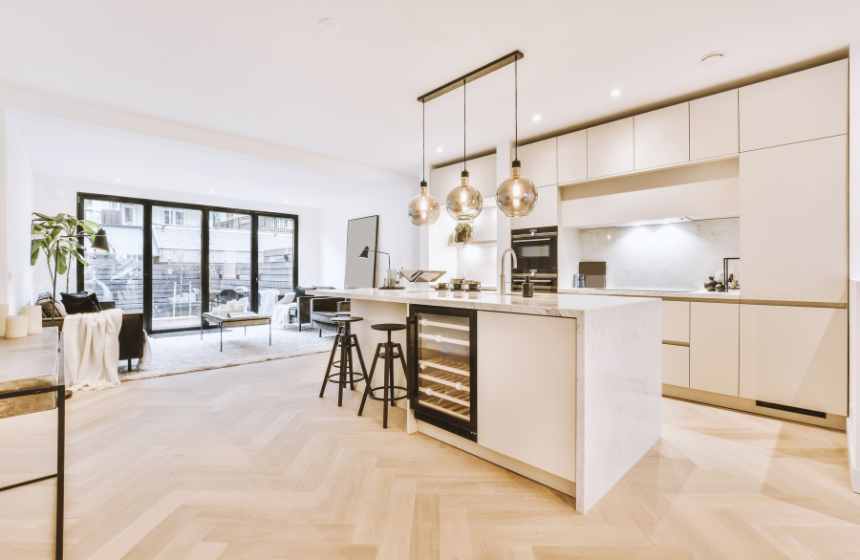
Using multilayered lighting techniques is an efficient way to set a number of moods and to upgrade the functionality and usability of your stylish living room and kitchen.
You can create various atmospheres blending different types of lighting for distinct activities, time of day, or specific events. And this way, this strategy will not only enhance the general ambiance but also imbue the area with depth and dimension.
a). Ambient Lighting for General Illumination
Ambient lighting comes first, providing basic light illumination that gives the whole space its character. This level of lighting ensures that the space is bright and accessible.
Good examples of ambient lighting are ceiling fixtures, like chandeliers, recessed lights, or pendant lights, because they give wide distribution all over the space.
Ambient lighting in the living room and the kitchen will diffuse the light all over the surfaces and eliminate the dark spots, making the spaces much more expansive and inviting.
Also Read: Biophilic Design: Integrating Nature into Modern Home Decor
b). Task Lighting for Focused Activities
Task lighting illuminates areas where tasks are to be performed. Under-cabinet lights in a kitchen illuminate countertops and workspaces so one can prepare meals more efficiently, quicker.
Reading or floor lamps in a family room may assist in keeping the ability concentrated upon regions for reading, crafting, and other task-oriented activities where focused lighting is necessary. It makes those rooms more useful.
c). Accent lighting highlights particular elements.
Accent lighting creates depth in the lighting scheme by highlighting key elements within the space. That’s a look that provides visual interest and calls attention to architectural details or decorative pieces.
Think about installing spotlights or track lights to highlight pieces of artwork, sculptures, or high-interest textures within your stylish living room and kitchen.
Pendant lights above a kitchen island or dining table can be decorative AND accent lighting, adding style and focus to those spaces.
d). Dimmer switches for adjustability
Dimmer switches give you the power to switch the brightness of your lighting. This power gives you the option to change the lighting according to your mood or interest in a task.
It is possible to dim the lights for a cozier evening or brighten them up for a more lively dinner party. Dimmer switches can become quite useful in open-plan situations, enabling one to adjust the moods of the kitchen and the living areas at the same time, perfect for any event.
e). Choosing the Right Color Temperature
Color temperature is highly important in layering your lighting. Warm tones, about 2700k-3000K, are ideal for a welcoming and cozy space, perfect for a living room or a dining area where a person desires to unwind.
Cooler tones over 4000K should be used in task-oriented places such as the kitchen, where bright light that concentrates on cooking or cleaning is required.
This ensures a precise balance of these temperatures throughout your home in order to get the ideal mix of comfort and functionality.
Also Read: Smart Home Decor: Technology with Style for a Modern Living Space
Conclusion
The stylish living room and kitchen shall consider color schemes, furniture layout, lighting, and storage solutions. A color palette, textures, finishes, and flexi furniture can then build a warm and functional home.
Lighting explains spaces and, consequently, the carefully planned furniture arrangement will promote comfort. This procedure aims to marry style with practicality while demonstrating personal taste and accommodating needs for daily living.
It hence builds a cozy environment for a homely or entertaining space.
Recent Posts
Here is reply of high-demand removable wallpapers. The wallpaper industry has changed a lot in recent times, with the launch of removable wallpaper being seen as a blessing for homeowners, renters,...
Brown is an often neglected color when considering interior design but brown decor living room ideas could make your house feel warm, sophisticated, and timeless. More adaptable than any other...
